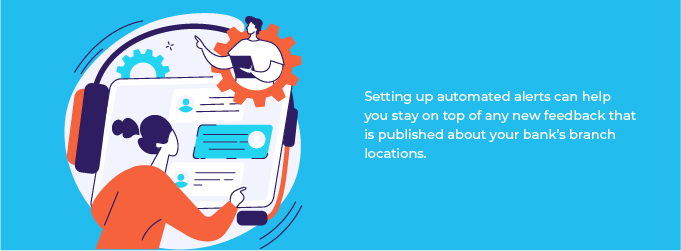Bank Reputation Management
Quality customer service, responsive management, and effective products and services—all fundamental requirements for building a strong brand reputation for any bank or credit union. But this is the digital world. That means few issues will be as vital to your reputation as one simple phrase:
Online reviews.
Many banks and credit unions understand that improving and managing their online reviews are essential for improving their financial institution’s public perception.
Today’s customers are more internet savvy than ever. Since about 82% of people prefer to research online prior to making a buying decision, it’s crucial for financial institutions to appear prominently and often in search engine results by continually improving website search engine optimization, both on-site and off-site. Online reviews are a big part of effective off-site SEO and should remain a top priority.
This can be challenging for community banks, as not all positive experiences that customers have will necessarily result in them thinking to leave a review online. On the other hand, it is more common for customers who have negative experiences to voice their opinions wherever they can, including on your bank branch’s local listing.
This makes it important for financial institutions to approach reputation management with a proactive mindset. Encouraging happy customers to post reviews of their own is an effective way to make your local bank stand out from the competition.
In this article, we will cover how to handle negative reviews, while also discussing how to earn positive reviews more frequently for your bank.
>Need a solution to claim all your local listings and solicit online reviews from a single dashboard? Check out BankBound Local.
How should banks and credit unions handle negative online reviews?

Scenario: You’ve just seen an online review that was posted for one of your branch locations. – What do you do next?
Whether this review is positive or negative, step one should be to make sure you craft a response to every piece of online feedback that comes through. Leaving a response is not just for the person who left the original review. Responses to reviews will be seen – and considered – by future prospects or customers who are shopping for a new place to do their banking.
People trust online reviews. According to a 2020 Bright Local survey, “87% of consumers read online reviews for local businesses in 2020.” They also noted that three of the five most important data points for consumers are star rating, recency, and quantity of online reviews. Therefore, having a lot of recent and positive (aka 4-5 star) reviews will likely impact consumer behavior and preference in favor of your brand.
Responding is even more crucial for negative reviews, so you will want to make sure they do not sit unattended for very long. The best course of action is to publish a public response to these reviews, and it may often be relevant to offer to take the conversation offline. You can use the public response as a way to recognize the issue, show that you hear them, and then provide them the best way to get in contact with a representative to resolve anything further.
For taking the conversation offline, it is important to have the customer raising the complaint to be the one who reaches out to the bank with a phone call or private email. It is difficult for your financial institution to confirm that the customer is who they say they are through an online review alone. Also, depending on the contents of the review itself, it may require discussing specifics of the customer’s account and services with the bank, so you certainly do not want to get into these details within your public-facing online conversation.
Another factor to consider is Google’s consideration of review responsiveness. For local listings in Google’s map pack search results, responding to customer reviews in a timely and consistent manner may impact the algorithm behind Google’s ranking decisions. Community banks and credit unions with a focus on local SEO can see substantial benefits from this increased visibility.
How can financial institutions be proactive about reputation management?

As a bank or credit union, your first step to becoming more actively engaged with your online reputation management is to have automated review notifications set up. This way, an alert is sent directly to you whenever an online customer review is posted. Having your antennas up will be a crucial component of making sure your responses to reviews are timely. Google takes response time into account, and so may your financial institution’s compliance team.
Having alerts set up will help with our previous point of responding to every online review, whether it is positive or negative. Email alerts can help you make this a part of your everyday checklist.
How can banks communicate internally and equip their team to help with review generation?

While online reputation management is largely a digital effort, there are other bank representatives who can lend a hand with generating customer reviews. Equipping customer-facing bank employees with the appropriate tools and information can go a long way with increasing your online review count.
Customers who have positive experiences do not tend to immediately think to post an online review, so it is important to do everything we can to hand them the opportunity to leave their feedback.
One way to approach this is by considering ways that you can remove any barriers that would typically keep a happy customer from publishing a positive review online. It is more likely for customers to submit their online review if it was just a click away, rather than having to jump through hoops to post their opinion. You can work toward improving the customer’s process in a handful of ways. A potential option is to implement an SMS system that will send customers a text message with a link to take them directly to where they can submit their online review. Frontline employees can help facilitate this by confirming with the customer that they are open to the bank sending them a text message prior to actually sending it. It is recommended to build out a spreadsheet of customers who have agreed to receive text messages to help you stay organized and execute on sending out communication to these customers effectively. This can help with cross-selling efforts for financial institutions as well, such as contacting happy loan customers to tell them about promotions for your bank’s deposit accounts.
Aside from soliciting reviews via SMS, a viable alternative is utilizing email communication in a similar fashion. Timing is key, as it is often best to request a review from a customer while their experience with your financial institution is still top of mind. For this reason, it’s recommended to reach out to customers soon after they have a recent interaction with your bank, such as after they open a new account or complete the process of closing a loan. There are tools and platforms available that can capture a Net Promoter Score® (NPS) while also helping email recipients find your Google Maps listings so they can provide public feedback.
One overlooked channel for soliciting reviews immediately after an engagement is your transactional receipts. In addition to branch teller receipts, consider asking for reviews as part of an ATM marketing strategy.
To put it simply, if a customer has a positive service experience with the bank, perhaps while opening an account or finalizing a loan, have the bank representative request permission to contact them via email or text message to leave an online review. This gives the customer a direct route for leaving a review that is only one click away on their mobile device.
Having a backup plan is a good practice to consider as well. Prepare cards that representatives can hand to customers in case they would rather not receive messages from your bank. This card can provide them with quick and easy steps for where they can go online to leave a review of their experience.
Where do I start with managing my bank’s online reputation?
One change that can be low-hanging fruit is ensuring that you have claimed and fully completed your branch location profiles across popular sites such as Google, Yelp, and Facebook. This will ensure more people can find you online organically, where they can then decide to leave a review.
Are you looking for assistance with reputation management for your bank or credit union?
If you need a second opinion about your online review strategy or would like an experienced partner to help you earn more reviews, don’t hesitate to contact us! Whatever you do, make online reviews a priority for your FI. After all, you work hard to delight your customers; the people who search for your bank or credit union online deserve to know that.

